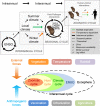The ecological dynamics of hantavirus diseases: From environmental variability to disease prevention largely based on data from China
- PMID: 30789905
- PMCID: PMC6383869
- DOI: 10.1371/journal.pntd.0006901
The ecological dynamics of hantavirus diseases: From environmental variability to disease prevention largely based on data from China
Abstract
Hantaviruses can cause hantavirus pulmonary syndrome (HPS) in the Americas and hemorrhagic fever with renal syndrome (HFRS) in Eurasia. In recent decades, repeated outbreaks of hantavirus disease have led to public concern and have created a global public health burden. Hantavirus spillover from natural hosts into human populations could be considered an ecological process, in which environmental forces, behavioral determinants of exposure, and dynamics at the human-animal interface affect human susceptibility and the epidemiology of the disease. In this review, we summarize the progress made in understanding hantavirus epidemiology and rodent reservoir population biology. We mainly focus on three species of rodent hosts with longitudinal studies of sufficient scale: the striped field mouse (Apodemus agrarius, the main reservoir host for Hantaan virus [HTNV], which causes HFRS) in Asia, the deer mouse (Peromyscus maniculatus, the main reservoir host for Sin Nombre virus [SNV], which causes HPS) in North America, and the bank vole (Myodes glareolus, the main reservoir host for Puumala virus [PUUV], which causes HFRS) in Europe. Moreover, we discuss the influence of ecological factors on human hantavirus disease outbreaks and provide an overview of research perspectives.
Conflict of interest statement
The authors have declared that no competing interests exist.
Figures




Similar articles
-
New ecological aspects of hantavirus infection: a change of a paradigm and a challenge of prevention--a review.Virus Genes. 2005 Mar;30(2):157-80. doi: 10.1007/s11262-004-5625-2. Virus Genes. 2005. PMID: 15744574 Review.
-
A novel Sin Nombre virus DNA vaccine and its inclusion in a candidate pan-hantavirus vaccine against hantavirus pulmonary syndrome (HPS) and hemorrhagic fever with renal syndrome (HFRS).Vaccine. 2013 Sep 13;31(40):4314-21. doi: 10.1016/j.vaccine.2013.07.025. Epub 2013 Jul 24. Vaccine. 2013. PMID: 23892100 Free PMC article.
-
Hantavirus infections.Rev Sci Tech. 2000 Apr;19(1):64-78. doi: 10.20506/rst.19.1.1209. Rev Sci Tech. 2000. PMID: 11189727 Review.
-
Co-circulation of three pathogenic hantaviruses: Puumala, Dobrava, and Saaremaa in Hungary.J Med Virol. 2009 Dec;81(12):2045-52. doi: 10.1002/jmv.21635. J Med Virol. 2009. PMID: 19856478
-
Hantaviruses and their hosts in Europe: reservoirs here and there, but not everywhere?Vector Borne Zoonotic Dis. 2010 Aug;10(6):549-61. doi: 10.1089/vbz.2009.0138. Vector Borne Zoonotic Dis. 2010. PMID: 20795916 Review.
Cited by
-
Update in Viral Infections in the Intensive Care Unit.Front Med (Lausanne). 2021 Feb 23;8:575580. doi: 10.3389/fmed.2021.575580. eCollection 2021. Front Med (Lausanne). 2021. PMID: 33708775 Free PMC article. Review.
-
SARFIMA model prediction for infectious diseases: application to hemorrhagic fever with renal syndrome and comparing with SARIMA.BMC Med Res Methodol. 2020 Sep 29;20(1):243. doi: 10.1186/s12874-020-01130-8. BMC Med Res Methodol. 2020. PMID: 32993517 Free PMC article.
-
Veterinary informatics: forging the future between veterinary medicine, human medicine, and One Health initiatives-a joint paper by the Association for Veterinary Informatics (AVI) and the CTSA One Health Alliance (COHA).JAMIA Open. 2020 Apr 11;3(2):306-317. doi: 10.1093/jamiaopen/ooaa005. eCollection 2020 Jul. JAMIA Open. 2020. PMID: 32734172 Free PMC article. Review.
-
Intrinsic and extrinsic drivers of transmission dynamics of hemorrhagic fever with renal syndrome caused by Seoul hantavirus.PLoS Negl Trop Dis. 2019 Sep 23;13(9):e0007757. doi: 10.1371/journal.pntd.0007757. eCollection 2019 Sep. PLoS Negl Trop Dis. 2019. PMID: 31545808 Free PMC article.
-
Hantavirus Pulmonary Syndrome Outbreak Anticipation by a Rapid Synchronous Increase in Rodent Abundance in the Northwestern Argentina Endemic Region: Towards an Early Warning System for Disease Based on Climate and Rodent Surveillance Data.Pathogens. 2024 Sep 2;13(9):753. doi: 10.3390/pathogens13090753. Pathogens. 2024. PMID: 39338944 Free PMC article.
References
-
- Vaheri A, Strandin T, Hepojoki J, Sironen T, Henttonen H, et al. (2013) Uncovering the mysteries of hantavirus infections. Nat Rev Microbiol 11: 539–550. - PubMed
-
- Hart C, Bennett M (1999) Hantavirus infections: epidemiology and pathogenesis. Microbes Infect 1: 1229–1237. - PubMed
-
- Nichol ST, Spiropoulou CF, Morzunov S, Rollin PE, Ksiazek TG, et al. (1993) Genetic identification of a hantavirus associated with an outbreak of acute respiratory illness. Science 262: 914–917. - PubMed
Publication types
MeSH terms
LinkOut - more resources
Full Text Sources
Medical

